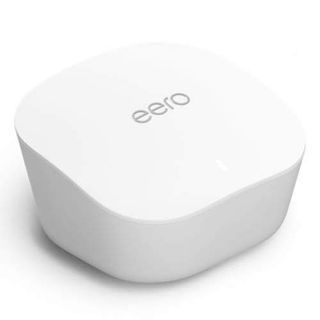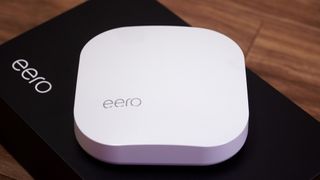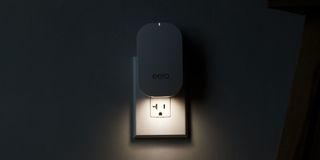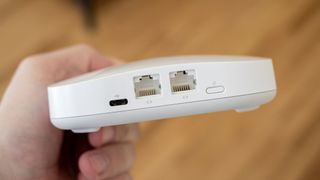Eero vs. Eero Pro: What are the differences and which should you buy?
The tri-band eero Pro keeps speeds higher even when you're connected to a mesh node.


Compact and cheap
This Eero sets its target on affordability and simplicity with enough speed for most. It stays focused on simplicity, beauty, and ease of use with great software and support for Amazon's Alexa assistant. This is a great start or expansion to an Eero mesh network.
For
- Compact units are easy to position
- Compatible with other eero models
- Support for eero features like eero+
Against
- Slow compared to modern versions
- Dual-band Wi-Fi means slower mesh performances
- Stripped down software

Faster mesh performance
With a tri-band connection, eero Pro can keep speeds high even with a mesh in place. The third band can be used for the eero's link to the mesh network, leaving one open for devices. Unlike a dual-band router, the Pro doesn't need to split the bandwidth. The eero Pro is a better fit for faster internet connections.
For
- Faster mesh speeds with a tri-band connection
- Compact size
- Compatible with other eero models
- Supports modern eero features like eero+
Against
- No Wi-Fi 6
- Stripped down software
Technically speaking, the eero Pro is the more capable router, but at double the price of the base eero, it's not worth it for most people. Eero Pro makes the most sense for someone with an internet connection over 500Mbps that wants to make sure they don't give up performance with a full mesh system. Quite a few people don't have an internet connection that's quite that fast, and for those people, the base eero will be fast enough, and the lower price leaves room for more units, which could result in more flexible and extensive coverage.
eero vs. eero Pro: An extra band adds a ton of speed
Why you can trust Android Central
The biggest difference between these two routers is the extra 5GHz band on eero Pro. This extra band allows the router and mesh points to communicate at full speed without sacrificing the connection speed to devices. Like other eero routers, two auto-sensing Ethernet ports adorn the back allowing you to connect devices or run a wired backhaul to a mesh point.
The standard eero is no slouch, though. AC1300 speeds with MU-MIMO support can quickly manage traffic with multiple connections. You can safely expect the software experience on the two devices to be very similar. This is nice since the software is one of the strongest parts of the Eero experience.
| Header Cell - Column 0 | eero | eero Pro |
|---|---|---|
| Wi-Fi standard | Wi-Fi 5 (802.11ac) Dual-band | Wi-Fi 5 (802.11ac) tri-band |
| LAN ports | 2 per router | 2 per router |
| Frequencies | 2.4GHz and 5.2GHz | 2.4GHz, 2x 5GHz |
| Dimensions | 3.85 x 3.85 x 2.36 inch | 4.76 x 4.76 x 1.26 inch |
| CPU | 700Mhz quad-core | 700MHz quad-core |
| RAM | 512MB | 512MB |
eero vs. eero Pro: The software
The software experience will be largely the same no matter which eero device you have. You need access to an Android or iOS device to set up and configure your eero network. Make sure to grab the app on Google Play before disconnecting your old equipment.
The eero routers will update themselves when new software is available, so you shouldn't need to worry about that aspect. As you would expect from an Amazon product, both of the eero routers are Alexa-compatible. Even the older eeros can use Alexa.

eero vs. eero Pro: How much speed is enough?
The standard eero comes in at AC1300 speed, breaking down to 400Mbps at 2.4GHz and 866.6Mbps at 5GHz. Since this router needs to share its 5GHz band with the mesh points, you'll mostly max out at half of that 5GHz speed, as shown in our eero review. Still, this is plenty for most people with enough speed for streaming 4K and browsing. The only place you'll really feel that speed restraint is during large downloads. This is assuming you have an internet connection that fast.
If you're one of the people with a fast connection that demands a faster Wi-Fi solution, the extra 5GHz band allows eero Pro to deliver speeds without cutting them in half. In the perfect world, that would be the full 866.6Mbps, but it will be less in reality. Amazon recommends the eero Pro for connections up to 550Mbps.
eero vs. eero Pro: Coverage and expansion
Eero Pro has the edge in coverage but only just. At 1,750 sq ft compared to eero's 1,500 sq ft, it's safe to assume that most people will need more than one Eero in their home. If you generally have good coverage in your home, it's worth considering if you even need a mesh system. If you want to build a mesh and you know you need a boost in coverage, the Eero line has many great expansion options.

One nice thing about being part of the eero ecosystem is that all of the eero devices will be compatible. If you want, you could buy both of these products and use them together. If you're looking at these devices for expansion, it's a good idea to put the most powerful device at the center connected to your modem. Your entire network will only ever be as good as the main router.
You can mix and match eeros as needed. If you only need a basic connection in one part of your home, a base eero or eero Beacon will work fine with an eero Pro. There is an eero 6 Extender that comes equipped with Wi-Fi 6; however, keep in mind that the mesh's connection will fall back to Wi-Fi 5. If you're expanding an eero mesh, the Beacon is a bit slower than other options.
Both the eero and the eero Pro have two gigabit RJ45 Ethernet ports as well. Keeping your wired devices connected will be easier than ever since you can plug into the nearest router.

eero vs. eero Pro: What about Wi-Fi 6?
Amazon has steadily updated the eero line with newer models, including four new consumer models with Wi-Fi 6 and some eero built-in devices like Amazon Echo Dot. While Wi-Fi 6 isn't strictly necessary for many people, it is faster than Wi-Fi 5 by a significant margin and can stand up better to congestion. Wi-Fi 6 eeros will also be able to use the newer tech to link the nodes meaning that even the dual-band eero 6 is a big upgrade over eero and, in some cases, even faster than eero Pro.
We were impressed in our eero 6+ review at the speeds possible with the newer mesh router. We were also generally satisfied with the overall network performance in our eero Pro 6E review. If you've got an internet connection of or over 1Gbps, these newer eeros will help you get every megabit you pay for.
eero vs. eero Pro: Which should you get?
For most consumers' needs, the standard eero offers more than enough speed and remains one of the best wireless routers you can get. While the eero Pro will handle more devices and has more raw speed, unless you have a full house with data-hungry users, the standard eero should be plenty.
If you are building a mesh to solve a speed and capacity problem, the eero Pro is the better move, but if you want Wi-Fi that's good enough for pretty much any standard usage, the standard eero is a better value. Plus, you can get more units to further improve coverage for the same budget.

Good enough for most people
Whether you're building a new eero mesh or expanding an old one, the base eero will be a great fit with enough speed for most. You can even use them for expansion with a faster eero mesh down the line.

You have a lot of devices that need more speed
Eero Pro keeps speeds high even with a mesh thanks to a tri-band setup, and can even be expanded with any other eero you can get. Despite its faster speeds, it's still one of the smallest routers you can buy.
Be an expert in 5 minutes
Get the latest news from Android Central, your trusted companion in the world of Android
When Samuel is not writing about networking or 5G at Android Central, he spends most of his time researching computer components and obsessing over what CPU goes into the ultimate Windows 98 computer. It's the Pentium 3.

